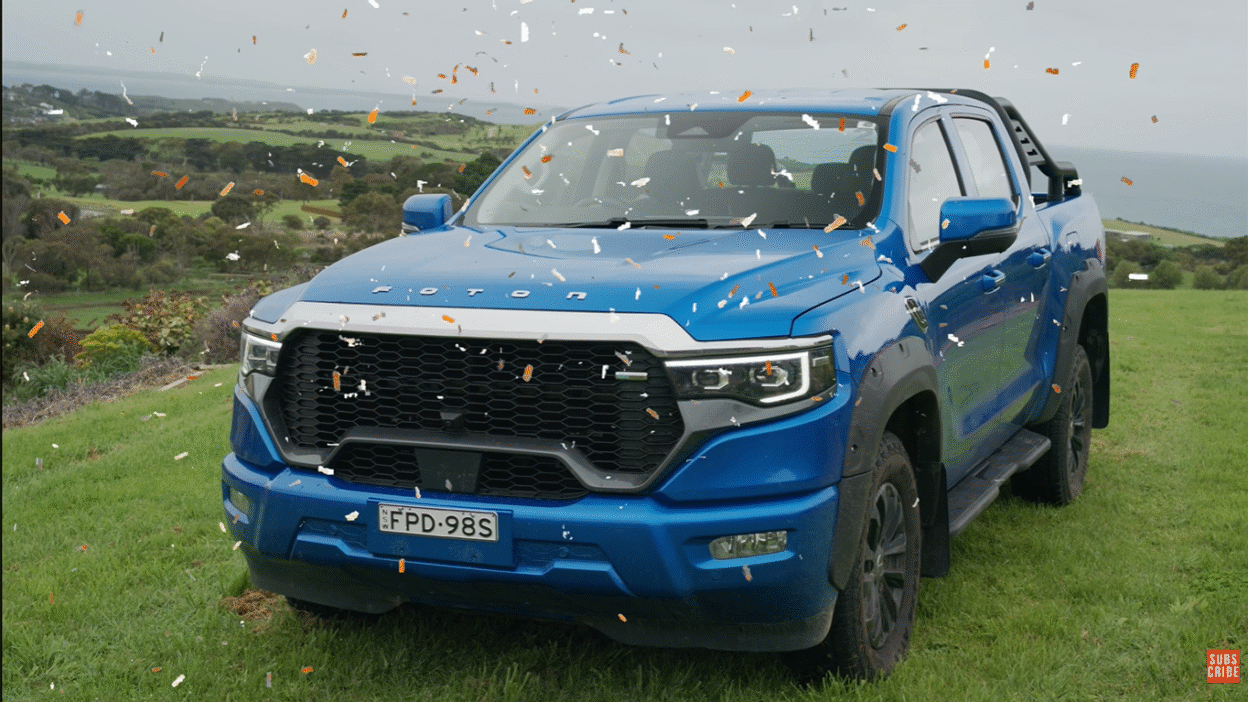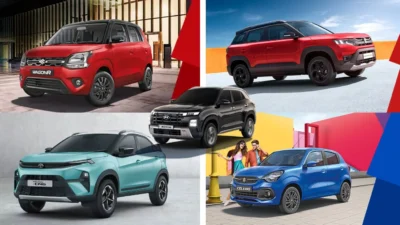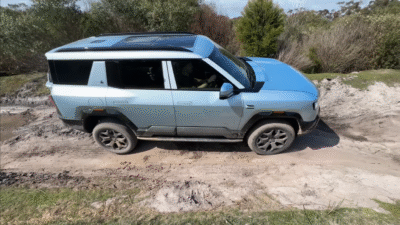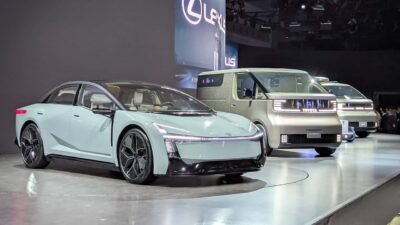The 2026 Foton Tunland storms back into Australia after a six-year break, now imported by Inchcape. This massive dual-cab ute sits between midsize and full-size pickups, with a bold RAM 1500-inspired face, quilted faux-leather interior, and a price tag under $50,000 before on-roads. The V9L trim stands out with multi-link rear suspension for comfort, heated seats, wireless CarPlay, and a 360-degree camera. But the 2.0L turbo-diesel mild-hybrid (120 kW / 450 Nm) feels underpowered, hitting 0–100 km/h in 13.3 seconds and averaging 11 L/100 km in real-world tests—far from the claimed 8 L/100 km. Marketing calls it a “hybrid diesel ute” and hints at “vehicle-to-load,” but it’s just a 48V system with a 300 W outlet. Towing reaches 3.5 tonnes on paper, yet the engine struggles. For lifestyle buyers who want size, luxury, and value without heavy hauling, it’s tempting. Tradies needing power or efficiency should look elsewhere.
Introduction: A Controversial Comeback
“WTF! Isn’t this illegal to sell?!” That dramatic opener from the Car Source YouTube review captures the shock of seeing the 2026 Foton Tunland in the metal. After disappearing from Australian roads in 2019, Foton returns with a vengeance—bigger, bolder, and cheaper than most expect. The Chinese giant, known for trucks and buses, partners with Inchcape (Subaru’s distributor) to relaunch this dual-cab ute.
The Tunland enters a red-hot market dominated by Toyota Hilux, Ford Ranger, Mitsubishi Triton, and newcomers like GWM Cannon Alpha and JAC T9. Foton positions it as a budget-friendly “lifestyle” ute with mild-hybrid tech, Euro 6 compliance, and features that punch above its price. But the video’s chaotic 0–100 km/h launch—13.92 seconds in the rain—raises eyebrows. Is this a bargain or a bait-and-switch?
This review dives deep into every angle: design rip-offs, interior surprises, sluggish performance, and whether the marketing hype holds up. If you’re a tradie, weekend warrior, or just curious about Chinese utes, read on to see if the Tunland deserves your hard-earned cash.
Foton Tunland 2026 Overview
Foton tried Australia twice before—first via Tynan Motors, then factory-backed. Both failed. Third time’s the charm with Inchcape’s distribution muscle. The 2026 Tunland arrives refreshed, built on a ladder-frame chassis with a 48V mild-hybrid system tacked onto a 2.0L turbo-diesel. It’s not a full hybrid; the tiny 370 Wh lithium-ion battery assists start-stop and low-speed torque, nothing more.
Target buyers split two ways: cost-conscious tradies eyeing the base V7C and lifestyle owners craving the plush V9L or V9S. Euro 6 emissions mean AdBlue refills, but the system promises cleaner running than older Chinese utes. Build quality feels solid—no rattles after off-road testing—and the overall package screams ambition. Foton wants to steal sales from established players by offering more metal, more tech, and more comfort for less money. The question is whether the powertrain can keep up.
Pricing and Variants
Foton keeps pricing aggressively, all under $50,000 before on-roads:
- V7C 4×2: $39,990 – Leaf-spring rear, work-focused
- V7C 4×4: $42,990 – Adds 4WD, higher payload
- V9L 4×4 (tested): $45,990 – Multi-link coils, lifestyle tune
- V9S 4×4: $49,990 – Sunroof, privacy glass, front diff lock
The V9L hits the sweet spot: comfort-oriented suspension, premium interior, and enough off-road gear for gravel roads. It undercuts the GWM Cannon Alpha diesel ($52,000+), Mitsubishi Triton GLS ($53,000), and even the JAC T9 top-spec. For the price of a mid-trim Hilux, you get a bigger ute with heated seats and a ZF 8-speed auto. Value looks strong on paper, but real-world fuel and performance will decide if it’s a winner.
Exterior Design: RAM 1500 Clone or Bold Original?
Love it or hate it, the Tunland’s face screams RAM 1500. The massive chrome grille, “PHOTON” bonnet lettering, stacked LED headlights, and chunky bumper are near carbon copies. The base V7C mimics a Ford F-150. Foton isn’t subtle about borrowing from American icons, but the execution works. The LED lights are bright, sequential indicators add flair, and a steel bash plate hints at toughness.
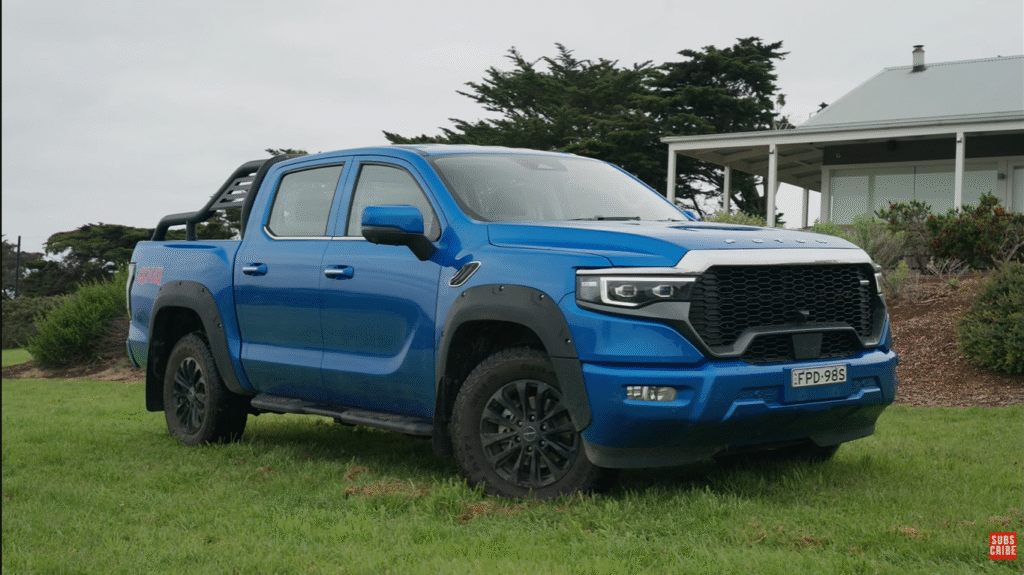
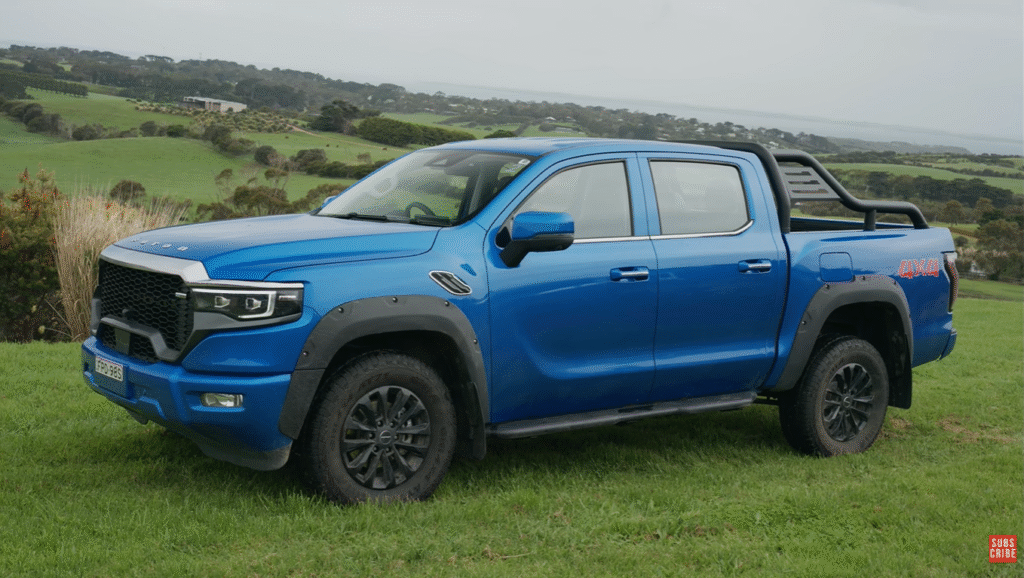
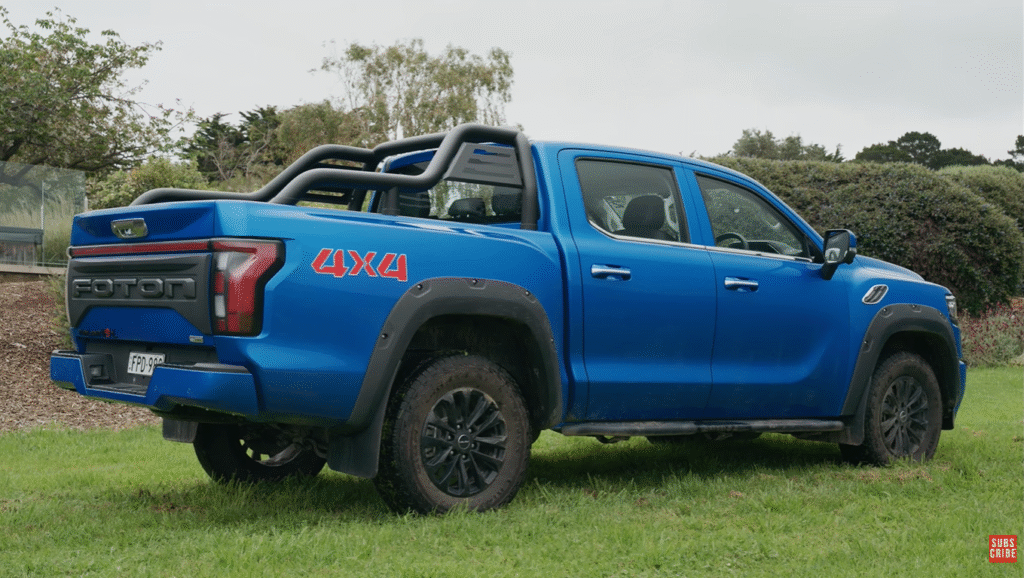
Side profile reveals the Tunland’s true size: 5,617 mm long, 2,090 mm wide, with a 3,355 mm wheelbase—longer and wider than a Ford Ranger. Muscular fenders, 18-inch alloys shod in GY 4×4 AT71 all-terrains, and studded cladding give it road presence. The V9L adds a metal side step (handy but boulder-prone) and a black sports bar. Rear design doubles down on branding: giant “PHOTON” tailgate letters, full-width LED light bar, and “TUNLAND V9L” badges. A hydraulic tailgate damper eases opening, though there’s no built-in step—climb via the tyre or bumper.
Overall, the look is derivative but cohesive. It turns heads without looking cheap, and the size makes the Rangers seem compact.
Dimensions, Payload, and Towing
The Tunland plays in the “super-midsize” sandbox:
- Length: 5,617 mm
- Width: 2,090 mm
- Wheelbase: 3,355 mm
- Ground clearance: 240 mm
- Wading depth: 700 mm
Tub dimensions impress: 1,577 mm long, 1,650 mm wide (1,240 mm between arches), 530 mm deep. A quality spray-in bedliner protects without overspray. Payload varies:
- V7C 4×2: ~1,100 kg
- V7C 4×4: ~1,050 kg
- V9L/V9S: 995 kg (under 1-tonne novated leasing threshold)
Towing rates at 3,500 kg braked (GVM 3,300 kg, GCM 6,800 kg), but the weak engine raises doubts. A full-size spare hangs underneath, and the V9L includes a rear diff lock (front lock on V9S). For light loads and occasional towing, it’s practical; heavy haulers should stick to leaf-spring V7C.
Interior Review: Surprisingly Premium
Step inside the V9L and prepare for shock. Soft-touch plastics cover the dash, doors, and armrests. Quilted synthetic leather seats feel plush—many mistake it for real hide. The chunky leather-wrapped steering wheel has a premium grip. A 12.3-inch digital cluster offers themes (classic, simple, movement), though some data vanishes depending on mode.
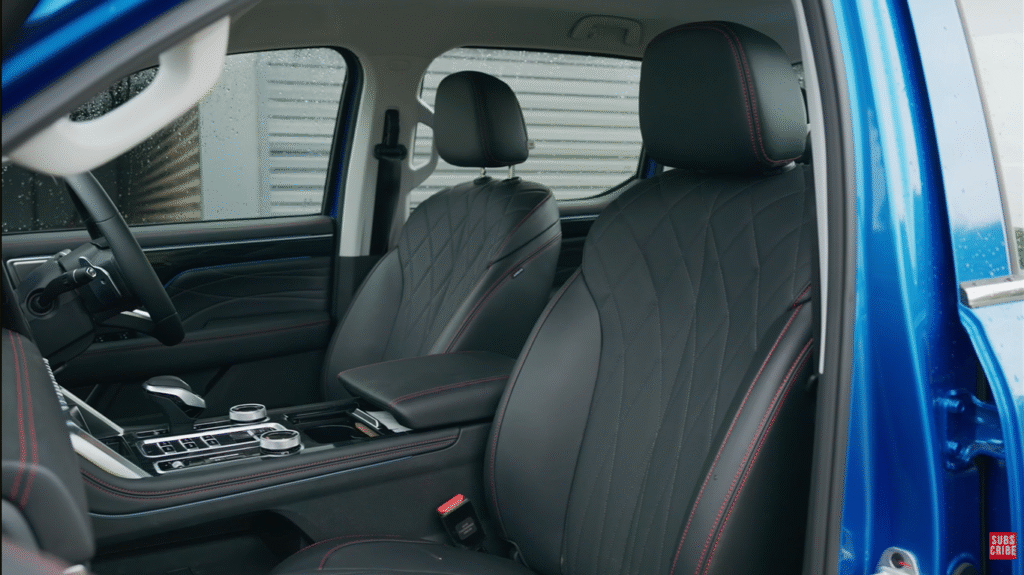
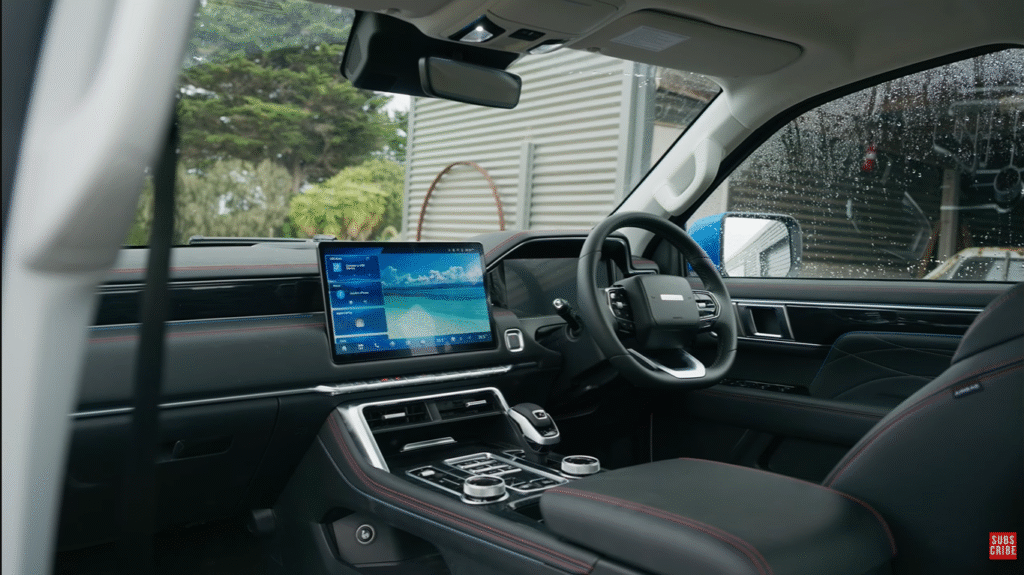
The 14-inch touchscreen runs an Android-based OS with wireless Apple CarPlay and Android Auto in full-screen glory. Physical climate buttons prevent menu diving, and heated seats (three-stage) warm quickly. A rubberized wireless charger keeps phones secure. The center console overflows with buttons: drive modes (Eco, Normal, Sport, Mud, Sand, Snow), 4WD selector, hill descent, and rear diff lock. Storage abounds—deep cooled armrest, huge glovebox, removable cupholders, and big door bins.
Compared to the aging Hilux cabin or plasticky JAC T9, the Tunland feels a generation ahead. It’s not Ranger-level refined, but at $45,990, it’s a steal.
Rear Seats & Practicality
Rear space benefits from the long wheelbase. Legroom and toe room are generous, and the seat base supports thighs well. However, the backrest lacks bolstering—thin and floppy on long drives. Quilted faux leather continues, with map pockets and a soft fold-down armrest holding cupholders.
Amenities include rear vents and a 220 V / 300 W socket. Foton calls this “vehicle-to-load,” but it’s misleading—enough for a laptop, not power tools. Flip the rear seat base to reveal flat floor storage; the 48V battery sits behind the cab. No under-seat bins, but the cavernous floor swallows gear. Overall, rear passengers travel in comfort, though support could improve.
Performance & Driving Impressions
The 2.0L turbo-diesel mild-hybrid produces 120 kW and 450 Nm, paired with a smooth ZF 8-speed auto. On paper, it’s adequate; in reality, it’s sluggish. Wet-weather 0–100 km/h attempts yielded 13.92 s and 13.3 s—embarrassing for a ute. Dry conditions wouldn’t shave much.
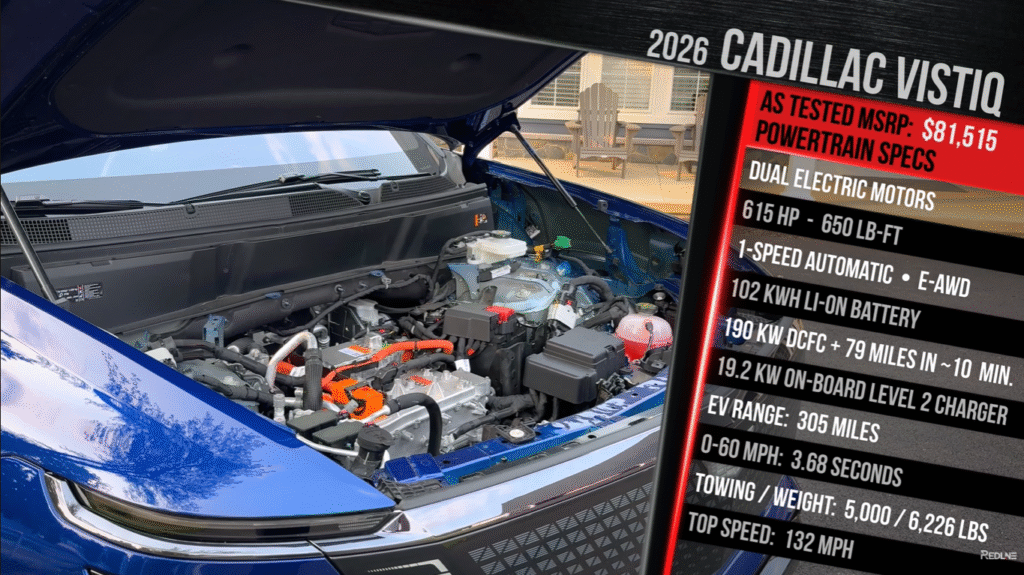
The mild-hybrid adds little punch; torque arrives late, and hills expose the power deficit. Real-world fuel economy averaged 11 L/100 km over 1,200 km—way off the 8 L/100 km claim. The GWM Cannon Alpha manages high 8s with more power.
Yet the Tunland redeems itself dynamically. Multi-link rear coils (V9L) deliver a supple ride—softer than Hilux leaf springs. Highway cruising is quiet on all-terrains, with adaptive cruise and lane centering working competently. Cornering defies the size; body roll stays controlled, and grip surprises. It’s no sports car, but it handles twisties better than expected.
Off-Road Capability
Part-time 4WD offers 2H, Auto, 4H, and 4L (low-range engaged in neutral). Rear diff lock is standard on V9L; front lock joins V9S. Terrain modes (Mud, Sand, Snow) adjust throttle and traction. The 240 mm clearance, 700 mm wading, and steel bash plate help on gravel and light trails. The 360-degree camera with transparent chassis view aids rock crawling.
It won’t match a Ranger Raptor, but for farm tracks or beach runs, it’s capable—especially with AT tires and diff locks.
Safety & Technology
Safety kit includes radar, front camera, adaptive cruise, lane keep, and AEB. Higher trims add more, but blind-spot monitoring and rear cross-traffic alert are absent on V9L. The 360-camera is clear, but it activates too eagerly. ANCAP testing is pending, but the structure feels robust.
Verdict: Should You Buy the 2026 Foton Tunland?
Strengths:
- Unbeatable price-to-size ratio
- Plush interior with modern tech
- Comfortable ride (V9L)
- Bold styling and features
Weaknesses:
- Gutless engine and poor acceleration
- Thirsty real-world fuel use
- Misleading “hybrid” and “V2L” claims
- Limited heavy-duty payload/towing
Ideal buyer: Lifestyle owners who tow occasionally, haul light loads, and prioritize comfort over grunt.
Rating:
- Design: ⭐⭐⭐⭐☆
- Interior: ⭐⭐⭐⭐☆
- Performance: ⭐⭐☆☆☆
- Value: ⭐⭐⭐⭐☆
- Overall: 7.8/10
If you can forgive the sluggish powertrain and marketing fluff, the Tunland V9L delivers serious bang for buck.
Bonus Section: Foton Tunland vs Rivals
| Model | Engine | Power/Torque | Price (AUD) | Fuel (real) | Strength |
|---|---|---|---|---|---|
| Foton Tunland V9L | 2.0L Turbo Diesel | 120 kW / 450 Nm | $45,990 | ~11 L/100km | Size + Interior |
| GWM Cannon Alpha | 2.4L Diesel | 135 kW / 480 Nm | $52,000 | ~8.5 L/100km | Better power + efficiency |
| Mitsubishi Triton GLS | 2.4L Diesel | 150 kW / 470 Nm | $53,000 | ~8 L/100km | Proven reliability |
No, it’s a 48V mild-hybrid for start-stop and minor assist only.
3,500 kg braked—but the engine struggles under load.
Expected 7 years / 200,000 km (confirm with dealer).
Yes for lifestyle use; skip if you need serious power or efficiency.
Source: 2026 Foton Tunland Review: WTF! Isn’t this ILLEGAL to SELL?!
